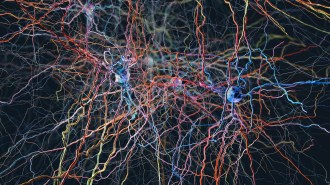In a tally of nerve cells in the outer wrinkles of the brain, a dog wins
Comparing neuron numbers across species could provide clues to animals’ smarts

BRAIN GAME Despite being relatively large, a brown bear’s brain is sorely lacking in nerve cells, while a raccoon’s cat-sized brain is packed full, finds a new study that tallies these neurons in carnivores.
Jeremy Teaford/Vanderbilt University
- More than 2 years ago
If more nerve cells mean more smarts, then dogs beat cats, paws down, a new study on carnivores shows. That harsh reality may shock some friends of felines, but scientists say the real surprises are inside the brains of less popular carnivores. Raccoon brains are packed with nerve cells, for instance, while brown bear brains are sorely lacking.
By comparing the numbers of nerve cells, or neurons, among eight species of carnivores (ferret, banded mongoose, raccoon, cat, dog, hyena, lion and brown bear), researchers now have a better understanding of how different-sized brains are built. This neural accounting, described in an upcoming Frontiers in Neuroanatomy paper, may ultimately help reveal how brain features relate to intelligence.
For now, the multispecies tally raises more questions than it answers, says zoologist Sarah Benson-Amram of the University of Wyoming in Laramie. “It shows us that there’s a lot more out there that we need to study to really be able to understand the evolution of brain size and how it relates to cognition,” she says.
Neuroscientist Suzana Herculano-Houzel of Vanderbilt University in Nashville and colleagues gathered brains from the different species of carnivores. For each animal, the researchers whipped up batches of “brain soup,” tissue dissolved in a detergent. Using a molecule that attaches selectively to neurons in this slurry, researchers could count the number of neurons in each bit of brain real estate.
For most animals, the team found the expected numbers of neurons, given a certain brain size. Those expectations came in part from work on other mammals’ brains. That research showed that with the exception of primates (which pack in lots of neurons without growing bigger brains), there’s a predictable relationship between the size of the cerebral cortex — the wrinkly outer layer of the brain that’s involved in thinking, learning and remembering — and the number of neurons contained inside it.
Story continues below interactive graphic
Feeling brainy
Comparing brain size and number of nerve cells in the cerebral cortex among several animal species revealed some surprises. Golden retrievers, for example, have many more nerve cells than cats, and brown bears have an unexpectedly low number of nerve cells given the relatively large size of their brain. Raccoons have a surprising number of nerve cells considering their small noggin. It’s too early, however, to say how neuron number relates to animal intelligence.
Tap or click the graph below for more information.
But some of the larger carnivores with correspondingly larger cortices had surprisingly few neurons. In fact, a golden retriever — with 623 million neurons packed into its doggy cortex —topped both lions and bears, the team found. (For scale, humans have roughly 16.3 billion neurons in the cortex.)
The brown bear is especially lacking. Despite being about 10 times bigger than a cat’s cortex, the bear’s cortex contained roughly the same number of neurons, about 250 million. “It’s just flat out missing 80 percent of the neurons that you would expect,” Herculano-Houzel says. She suspects that there’s a limit to how much food a big predator can catch and eat, especially one that hibernates. That caloric limit might also cap the number of energetically expensive neurons.
Another exception — but in the opposite direction — was the raccoon, which has a cat-sized brain but a doglike neuron number, a finding that fits the nocturnal mammal’s reputation as a clever problem-solver. Benson-Amram cautions that it’s not clear how these neuron numbers relate to potential intelligence. Raccoons are very dexterous, she says, and it’s possible that a beefed-up brain region that handles touch, part of the cortex, could account for the neuron number.
Herculano-Houzel expected large predators such as lions to have lots of neurons. “We went into this study with the expectation that being a predator would require smarts,” she says. But in many cases, a predator didn’t seem to have more neurons than its prey. A lion, for instance, has about 545 million neurons in its cerebral cortex, while a blesbok antelope, which has a slightly smaller cortex, has about 571 million, the researchers previously found.
It’s too early to say how neuron number relates to animal intelligence. By counting neurons, “we’ve figured out one side of that equation,” Herculano-Houzel says. Those counts still need to be linked to animals’ thinking abilities.
Some studies, including one by Benson-Amram, have found correlations between brain size, neuron number and problem-solving skills across species. But finding ways to measure intelligence across different species is challenging, she says. “I find it to be a really fun puzzle, but it’s a big challenge to think, ‘Are we asking the right questions?’”






